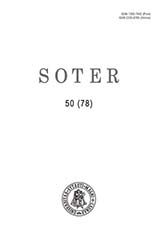Kryžius lietuvių tautinio identiteto simbolikoje
Cross in the symbolics of Lithuanian national identity
Author(s): Jolanta KontrimaitėSubject(s): Christian Theology and Religion
Published by: Vytauto Didžiojo Universitetas
Keywords: Kryžius; Kryždirbystė; Kryžių kalnas; Lietuvių tautinis identitetas; Tapatumo raiška; Simbolika; Cross; Cross-making; The Hill of Crosses; Lithuanian national identity; Expression of identity; Symbolics
Summary/Abstract: Straipsnyje nagrinėjamas lietuviško kryžiaus, kaip dvasinės ir materialinės kultūros objekto, simbolikos daugiareikšmiškumas. Liaudies meistrų sukurtas kryžius yra ne tik religinio, bet ir tautinio identiteto raiškos simbolis. Kryžių statymas – lietuvių tautos religinės bei tautinės saviraiškos reiškinys. Kryžių kalnas liudija lietuvių tautos religinį ir tautinį sąmoningumą. Tautinį identitetą atspindi atkaklus kryžių statymas draudimo metais, intencijų įrašų turinys. Kryžius yra tapęs tautos laisvės simboliu. Lithuania has experienced historical periods of losing and restoring the statehood, which resulted in social and cultural changes. Lithuanians have a lot of options and necessity to express their national identity in various forms and ways. Various spiritual and material culture objects have become symbols of national identity. Folk artists created crosses that were built not only in churches, churchyards, cemeteries, but also in villages, towns, streets, in front of public buildings, roadsides, picturesque places on hills or near springs. The cross has gained polysemous importance in particularly difficult historical periods during occupation. The object of the research – crosses created by Lithuanian folk artists. The aim is to look in crosses created by folk artists as a definition of national identity symbol. Objectives: 1) to discuss the originality and exclusivity of Lithuanian crosses; 2) to reveal the cross as becoming the symbol of Lithuanian identity; 3) to reveal the importance of the cross as Lithuanian symbolic tool for resistance during the periods of occupation; 4) to discuss the value of the Hill of Crosses as religious and national symbol of consciousness. Methods: literary analysis, synthesis and interpretation. The presented problem is the twofold nature of the symbolism of the cross: Lithuanian cross is not only religious symbol, but also that of national identity. The main conclusion indicates that Lithuanian crosses are unique and distinctive in their form, details of artistic expression and variety of characters. Part of symbols used in Lithuanian crosses are of non-Christian origin, but inherited from the ancient pre-Christian Lithuanian culture; therefore the crosses are even more distinctive and particularly exclusive folk art objects. Lithuanian folk memorials – crosses, shrines, roofed posts (stogastulpiai) – had great social significance to Lithuanian people’s spiritual life, ethical attitude, formation of sense of aesthetics, in particular during the periods of occupation. Crosses are not only Lithuanian landscape decorations, but also spiritual and ethical assets. The erection of crosses is the phenomenon of Lithuanian religiosity and especially of national freedom. It is the phenomenon of resistance which often was anonymous.
Journal: SOTER: religijos mokslo žurnalas
- Issue Year: 78/2014
- Issue No: 50
- Page Range: 81-94
- Page Count: 14
- Language: Lithuanian

